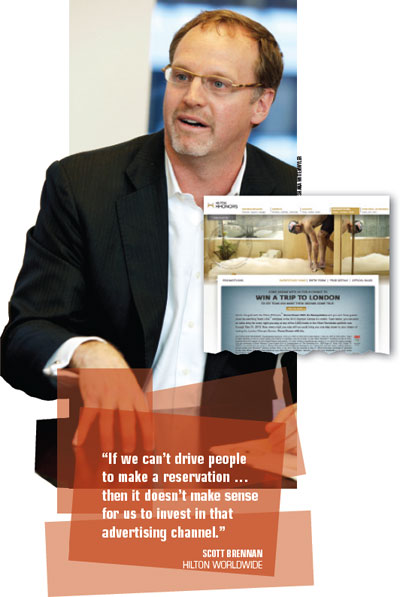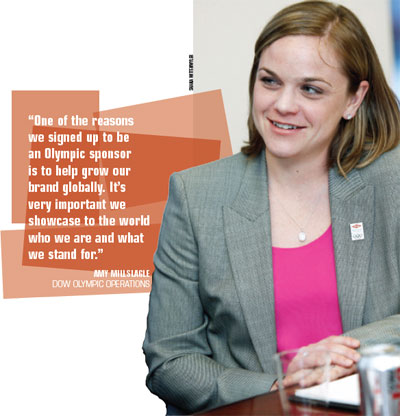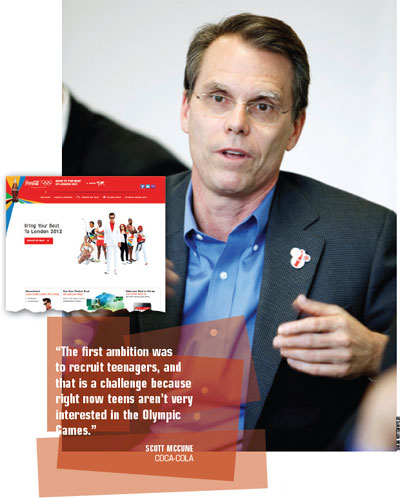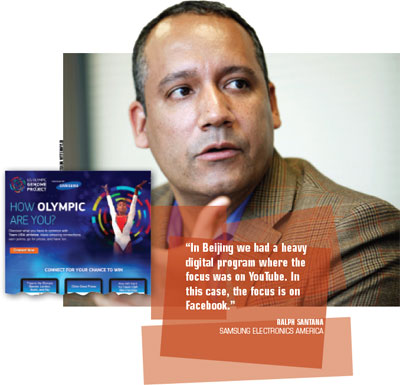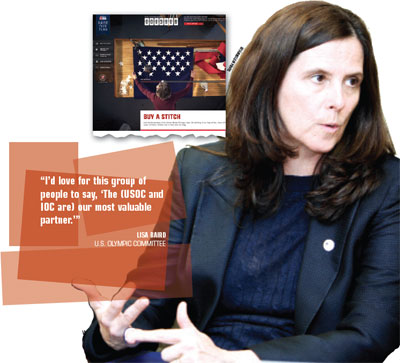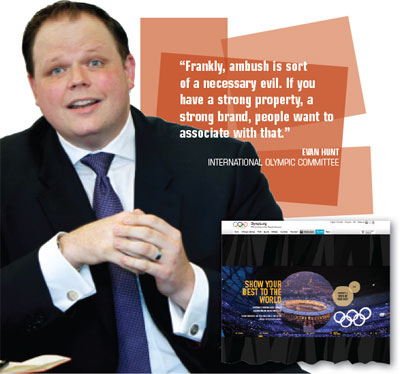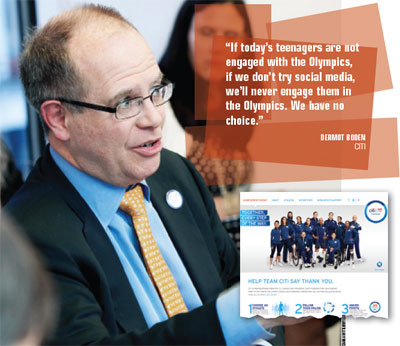Long before the Olympic flame was extinguished in Beijing, marketing executives began setting their sights on the 2012 London Games. London offers an opportunity like few Games before it. As one of the world’s most diverse and international cities, it promises to capture the attention of consumers, key customers and business partners in ways few Olympic cities can.
THE RING MASTERS
Here are the seven individuals who met with SportsBusiness Journal’s editorial team in New York City and a snapshot of the work their brand or property has launched ahead of the London Games.
Lisa Baird
Title: Chief Marketing Officer, U.S. Olympic Committee
Program: The USOC launched a fundraising campaign called “Raise Our Flag” in which it is asking donors to buy stitches, at $12 apiece, in the American flag that Team USA will carry in the opening ceremony on July 27. The flag is scheduled for completion in mid-July.
Dermot Boden
Title: Chief Brand Officer, Citi
Program: Citi created a marketing program that allows Americans to use Facebook and Twitter to direct $500,000 to nonprofit sports organizations selected by the bank’s 13 endorsed Olympic athletes. The program, called “Every Step of the Way,” is designed to allow Olympic athletes to thank the organizations that inspire them.
Scott Brennan
Title: Vice President, Global Strategic Partnerships, Hilton Worldwide
Program: Hilton launched a “Come Dream With Us” sweepstakes that will award one Hilton HHonors applicant a five-day trip for four to the London Games. The company also signed on as the presenting sponsor of the USOC’s “Road to London,” a series of digital news segments on athlete performances ahead of the Olympics.
Evan Hunt
Title: Head of Marketing Development, International Olympic Committee
Program: The IOC worked with WPP to develop the “Show Your Best” campaign. The effort includes a broadcast spot that features memorable Olympic moments and a website where visitors are urged to upload a video of their own athletic feats. It is giving away prizes for videos that align with Olympic ideals of excellence, friendship and respect.
Scott McCune
Title: Vice President, Worldwide Media, Sports and Entertainment Marketing, Coca-Cola
Program: Coca-Cola developed a global campaign called “Move to the Beat” that ties together music and sport. The company hired British music producer Mark Ronson, who has worked with Adele and the late Amy Winehouse, to develop a song based on sounds recorded at five athletes’ training sessions. It also developed an app so that consumers can make their own beats.
Amy Millslagle
Title: Marketing Vice President, Dow Olympic Operations
Program: Dow, which is focused on business-to-business opportunities, signed on to fund and help develop the fabric wrap for the 2012 Olympic Stadium. It also committed to support Sochi 2014 in the organizing committee’s efforts to build an ice rink in London during the Games.
Ralph Santana
Title: Chief Marketing Officer, Samsung Electronics America
Program: Samsung’s promotions in the U.S. are focused on its Genome Project, a Facebook application that shows users how they are connected to Olympic athletes. The app evaluates elements like where people are from or went to school and uses that information to compute the connections with athletes who train in the area or attended the same school.
— Tripp Mickle
ALL PHOTOS BY SHANA WITTENWYLER
As a result, corporate hospitality demands are at record levels, and there is intense pressure to develop marketing plans that resonate with consumers across outlets ranging from retail to Facebook to NBC.
SportsBusiness Journal last month convened the top marketing executives from five Olympic sponsors, the U.S. Olympic Committee and the International Olympic Committee to see how they’re managing that pressure. We talked about everything from social media’s effect on the marketing mix to measurement plans and ambush marketing to athlete endorsements.
With less than 75 days remaining before London’s opening ceremony, we wanted to share excerpts from that conversation, with answers edited for clarity and brevity.
MARKETING MIX:
Social media looms large in plans
■ What does your company’s marketing mix look like this time around?
SANTANA (SAMSUNG): Like everybody, when you look at your total marketing mix, there seems to be a heavier emphasis on digital. It will be a blended mix, but it will be a little bit heavier on digital. In Beijing, we had a heavy digital program where the focus was on YouTube. In this case, the focus is on Facebook.
BRENNAN (HILTON): We’ll be doing a lot of traditional print purchases with athlete images and sweepstakes promotions. We’ll rely heavily on a new sponsorship website we launched, which lets us funnel messages to our Hilton HHonors members and guests about the Olympics and the athletes Hilton has selected. Then there’s Twitter and Facebook promotions. For us, that is a change because in Beijing we were very TV heavy.
MILLSLAGLE (DOW): We’re doing a balance of traditional and untraditional. For traditional in the U.S., we’re doing TV advertising and out-of-home executions — taxicabs, billboards, etc. From a nontraditional standpoint, we’re helping build the ice rink in Sochi Park [the Russian organizing committee’s London promotion of the 2014 Winter Games] and helping to provide the stadium wrap for the Olympic Stadium [in London]. We’ll be bringing customers to feel and see those Dow solutions at play.
BODEN (CITI): It’s our first year involved in the Olympics. We’re learning how to engage. It’s going to be a lot of social media. The program we launched last week called “Every Step of the Way” is a way to engage with the athletes and with the programs that have inspired those athletes. But we will be doing classic, above-the-line media in the partnership we have with NBC. It’s a mix and I’d classify social as the star.
MCCUNE (COCA-COLA): For Coca-Cola, it varies by country. We had three ambitions for London. The first ambition was to recruit teenagers, and that is a challenge because right now teens aren’t very interested in the Olympic Games. But to drive our business in a global nature we had to find a way to become relevant to teens.
The second ambition was to make this a global platform. In Beijing, we had a China platform and 60 markets outside of China.
The third ambition was around how we think about marketing in ways that are liquid and linked, so how do we think about content and conversations in a way that’s liquid. Social is a part of that.
That’s what drove our approach to brand Coca-Cola, and it manifests itself in a marketing mix in different ways. In Eastern Europe and Southeast Asia, it’s heavily terrestrial television. In more developed markets like Japan and Korea and the U.S., there’s more mobile and social.
BAIRD (USOC): The amount of activation in the U.S. is at a new high. The number of materials being approved is double Beijing. Whether it’s social, TV, print, we’re seeing far more integrated campaigning and execution than we’ve ever seen before. The vibe for London is so positive. It’s almost like everybody’s home games.
■ Many of you mentioned social as being important. How significant was social in the planning process for you?
BRENNAN: Social lets it be a two-way conversation. It lets people who care about the Olympics tell us what they’re feeling and how our involvement in the Games is impacting them. Without the social component, it was much more of us telling them, “Here’s what we’re doing. Hope everybody likes it.” With social they can immediately tell you, “This is great. This isn’t so great.”
MCCUNE: All you have to do is look at a social graph. It’s enormous if you just use Facebook as your barometer from four years ago to today. Four years ago, Coca-Cola probably had 8 million Facebook fans. Today, Coca-Cola has 40 million. It’s fair to say it’s grown in that magnitude for all of our brands.
■ Is there a calculated risk in going social heavy in the sense that teens aren’t as heavily interested in the Olympics?
BODEN: The reverse is probably true. The risk is if we don’t start engaging. Our target isn’t teens at Citi. It’s an older audience. It’s 25-plus, probably in a certain socio-demographic target. But the reality is today that everyone is engaging through this, and if you’re not engaging in that way, then you’re not offering a full experience. That’s one argument for it.
The second argument is if today’s teenagers are not engaged with the Olympics, if we don’t try social media, we’ll never engage them in the Olympics. We have no choice.
SANTANA: I would add that when you really think about social in this particular round of the Olympics, the biggest risk is that companies or brands will chase it as a tactic and do social for the sake of social. If you don’t start with a clear idea of what your brand identity is or what you’re trying to accomplish and you don’t think about social as the tactic, the means to how, then you’re at risk. Then you’re just doing social for the sake of social.
I’m familiar with what all the brands are doing here and there are some really compelling things going on. What differentiates one idea from another is which ones provide utility. That’s important because there’s going to be more social information than ever. You’ll have athletes in the mix. Media in the mix. Brands in the mix. The only way to cut through all that clutter is to have a great idea.
GLOBAL CREATIVITY:
In TV campaigns, companies are developing one international message
■ With creative is it one message for all countries? Many messages for each country? What is the approach?
MCCUNE: The ambition [at Coca-Cola] was one idea, one message. The way we tried to recruit teenagers was knowing, “Yes, they like the athletes.” But we looked at what they are most passionate about: music.
What we did was take the combination of music, London, the social side of the Games and created a story around it. We got the producer Mark Ronson, who has worked with Adele and the late Amy Winehouse, and we signed up five athletes from around the world — the U.K., the U.S., Singapore, Russia and Mexico. And then Mark Ronson brought in a young talent named Katy B and put together a song around the sound of sport. The story about Mark Ronson’s journey called “Move to the Beat” is the common [creative] idea across all countries for Coca-Cola.
BRENNAN: We are a USOC sponsor and a China Olympic Committee sponsor. We built all of our campaigns around the concept of “Come Dream With Us.” It’s the promotion we’re running in the U.S. Some of the messaging remains the same, the imagery and what it evokes remains the same, but the actual wording of it had to be changed to meet local needs in China.
MILLSLAGLE: You typically haven’t seen Dow out in the forefront in a huge advertising way. One of the reasons we signed up to be an Olympic sponsor is to help grow our brand globally. It’s very important we showcase to the world who we are and what we stand for. You will see our “Solutionism” campaign launched this summer at the Olympics and it will have the same messaging throughout the world. Images may change to fit but it will be the same message, look, tone and feel.
■ How many of you are advertising on NBC? Why and why not?
MILLSLAGLE: One of Dow’s key targets overall is what we call key influencers, so thought leaders in the space of science, technology and folks on Wall Street. Advertising in the U.S. is a great way to reach these individuals and help them understand what we’re about. We’re trying to show folks we’re not the commodity chemical company we used to be. We’re a solutions provider.
BRENNAN: We found many elements of the NBC advertising proposal enticing, but honestly this Games period does not line up well with the booking window. If we can’t drive people to make a reservation with us as they’re sitting there watching the Olympics on TV, then it doesn’t make sense for us to invest in that advertising channel. We did choose to divert to digital and print.
MCCUNE: We look at NBC and they do an incredible job of telling the Olympic and athlete stories. You look at the cumulative audience and it’s 17 Super Bowls, back-to-back-to-back-to-back. It’s a great reach vehicle. Specifically in the U.S., besides recruiting teens, one of the key areas is shoppers and moms. If you start to look at ratings and the audience mix, NBC delivers a very wide audience.
BAIRD: People haven’t looked at advertising as a destination during the Olympic Games like the Super Bowl, but they will. We’re excited about seeing that type of phenomenon take effect.
BODEN: When Citi got into the Games and partnered with the USOC and NBC, we saw an opportunity to reconnect, to really start re-establishing ourselves back in the U.S. as America’s global bank, a bank that is American and a bank that connected more with a warmth and a sincerity. The Olympics undoubtedly offers us that opportunity.
MEASURABILITY:
Brands look to improve brand perception but need to track those improvements
■ What do you want said about your company or property at the end of the Olympics?
SANTANA: That Samsung transformed the way people connected with the Olympic movement by showing them they’re connected in ways they otherwise would have never known. And ultimately that we’re able to leverage the power and cultural currency of that movement to keep this brand top of mind for consumers.
BAIRD: I’d love this group of people to say, “The [USOC and IOC are] our most valuable partner.’”
MCCUNE: Our benchmark is that our annual report for 2010 said that the FIFA World Cup drove our business in the second and third quarter. I would love for our 2012 annual report to say the Olympic Games drove our business.
HUNT (IOC): It’s important that our partners have the best experience they possibly can. Those aren’t hollow words. Everyone on our team is working hard to deliver for our partners.
BRENNAN: We’d like to have people say that Hilton helped enable the furtherance of world peace and the ideals of the Olympics and as a result of that we’ve been able to reach out and touch the people who care about the Olympic movement internationally.
MILLSLAGLE: For Dow, it’s twofold. It’s for the world to finally see the role that chemistry plays in the world of sport, and that Dow helped the athletes compete and achieve their dreams, that spectators could watch comfortably and do all of this in a sustainable and safe manner.
BODEN: It’s Citi’s 200th anniversary this year. What a wonderful year this is for us to be celebrating that and be partnering with the U.S. Olympic Committee and the Olympic movement on the whole. In that history, we’ve been part of some incredibly important moments in the progress of humankind — the Panama Canal, the Boeing jet, the Marshall Plan and so forth. I would love to see coming out of this that people understand that we are a partner as people progress on their journey, from a line we’re using, from ambition to achievement.
■ At Dow and Citi, you’ve talked about influencing brand perception. How are you going to measure that before and after the Games?
MILLSLAGLE: At Dow we’re a bunch of engineers, so there’s a lot of math and science going on. We do brand tracker surveys pre and post. We’ll do individualized brand tracker surveys for people we bring to the Games. We’re doing quantitative studies with our employees to see if it is motivating them. We’re asking: Are we getting better recruits because of the Olympics? It’s very quantitative-based so we can see what we did well, what we should replicate moving forward.
BODEN: You sound like my bankers. They’re measuring everything, too. My previous life was at LG. The one thing everyone at LG understood was numbers. Data. It’s very important to lay out quite clearly what you’re trying to achieve. There are clear metrics. The metrics may be more around creating a sense of connection, emotion. We are also, though, trying to seek the benefit of selling product. A significant portion of the campaign, 30 or 40 percent, is going to be around selling products, credit card products, banking products. There are a series of metrics.
SANTANA: Everyone is saying it in different ways, but it’s brand equity and sales. On the equity side, specific to Genome, the things that we’re looking at are engagement, time spent with the app, how many people are sharing the app. On the sales side, we’ve got some clear messages around click-throughs on our website to products we’re going to be launching. We’re going to be doing pre and post analysis.
■ On the sales side for Hilton and Coca-Cola, when do you start seeing sales lift and when do you start looking for it?
BRENNAN: We’ve already started to see it. As soon as we begin putting consumer-facing promotions in the marketplace, we can immediately start to track a direct response to that. Our “Come Dream With Us” sweepstakes in the U.S. is really off to a roaring start. It looks like we’re going to be very successful.
MCCUNE: We’re looking at outcomes rather than outputs. We track outputs: how many impressions, how many expressions, time spent. But at the end of the day it’s outcomes. Did we change consumers’ attitudes and behaviors towards our brand? And did we sell more of our product more profitably?
■ When will you see those sales?
MCCUNE: It depends on when a country activates. We do these programs to build displays. Everyone who’s been in our business knows — you get displays built and it goes out the door. Now it’s a matter of did it go out more profitably than it did before — did more go out the door.
BODEN: We have to be careful about this idea that it’s automatically going to drive sales. In our industry, it’s all about improving the propensity to engage. There are measurements that are going to be absolutely critical. As long as I’m bringing people to the branch or getting people to access our website on cards, then this association is probably doing its job. After that, can the next part of it deliver? That’s why I get concerned when people say, “Exactly what sales do you expect as a direct consequence of this?”
MILLSLAGLE: We’re somewhat similar to you in that engagement factor. In the Olympic space we’re able to bundle all of our solutions — plastics, wire and cable, construction — together and target a bigger, higher order. We’ve been working on Sochi [2014], Rio [2016] and Korea [2018]. For us it’s an infrastructure play so it’s many, many years out.
■ Are the USOC and IOC doing anything differently with measurement than you’ve done in the past to assist partners?
BAIRD: We do a pre-tracking study that has a number of measurements. We listened to our partners and made a number of changes in it so we have the right inputs and are tracking the right engagement. That pre-tracking has just gone out and that will be our baseline measurement for this year’s activation.
HUNT: We have introduced a new servicing model that’s very much focused on the values derived from the partnership, which I would say is focused on unique systems of measurement determined partner by partner. You look at GE or Dow, a lot of the value derived is on early integration. It’s important we make sure that they have a seat at the table with Pyeongchang [South Korea, site of the 2018 Winter Olympics] now as they’re rolling out their infrastructure projects. Whereas with other partners it skews very much to before the event and now. It’s not a one-size-fits-all model. It’s a new process for us. But it’s really important for us that we are able to show that here’s a return on investment.
AMBUSH:
The amount of ambush marketing is expected to hit record levels
■ What is the ambush temperature right now? It seemed to be there were more ambush activities around Vancouver than Beijing. What’s the read going into London?
HUNT: Frankly, ambush is sort of a necessary evil. If you have a strong property, a strong brand, people want to associate with that. As I look at activity for London, we’re seeing on a global scale the number of submissions that have come through and will come through is almost a 1,000 percent increase from Beijing.
BAIRD: We’ve taken the stance that it’s much better to be proactive about ambush than reactive. A couple of steps we’ve taken: In December we had a congressional hearing on the Hill and we did a briefing for Congress on what exactly ambush is in the United States and how it hurts the athletes when someone tramples on our rights. We have made a huge effort to do outreach to people to make sure not only are they not ambushing intentionally but also that they know what the rules are. The rules of the Olympic movement are a little more complicated, so explaining it to people is important. Last fall, we did a sports agent workshop with the agents representing the top 150 athletes in the United States. We explained the rules and since then we’ve just had a lot more proactive outreach from agents saying, “Is this an issue? Is this?”
■ For the USOC and IOC, has the move into social created any complications in protecting sponsors?
HUNT: The old adage in sports marketing is you have to protect what you sell. That’s very much at the forefront of our mind because social has become such a dynamic in everyone’s program here that we have to take the appropriate steps to protect everyone’s rights. Some of the output of that is we have very good relationships with Facebook and Google.
BAIRD: With the mass and the quantity of dialogue that is going to be going on, monitoring that is going to be a challenge. We’re staffing up to be able to monitor where we think there may be rights issues.
SANTANA: Most corporations, at least ones that are part of the movement, are really clear internally about, “Here are the rules of the road.” We’re clear internally at Samsung about our rights, so there’s less of a risk within our corporations of social to be something that inadvertently causes an issue.
HUNT: That’s an interesting point because one of the worst types of ambush is sponsor-on-sponsor ambush. Social kind of raises the likelihood of that.
■ Do you feel better protected than four years ago?
MCCUNE: It’s hard to say. We don’t spend a lot of time worrying about it. That’s their job. Our job is to go engage consumers, engage customers and shoppers.
■ How important is the Olympics’ association with world peace and bringing the world together? Would you be sitting here if the Olympics didn’t have that association?
BRENNAN: I say no. If you look at the principles Hilton was founded on, world peace through travel and tourism, you couldn’t find anything more aligned with that than what the IOC and USOC stand for.
MILLSLAGLE: I’d say the same for Dow. For us, the Olympics stands for the improvement of human progress through sport. From a Dow Chemical standpoint, it’s the improvement of human progress through science. We see a marriage between the Olympics and Dow as very natural. Through research and science, we’re able to make advances that the athletes can use. We can make advances in the seats that spectators have to sit in. The ideals match up.
SANTANA: If you really peel back the values of the Olympic movement with any major corporation there are going to be some common threads. The question is, How do you localize that and how do you capture and express those values in what your activation is all about?
■ At the same time, the Olympic halo effect from its promotion of peace and bringing the world together also puts a big target on the event and sponsors. Protesters are using that to attack brands. We’ve seen that with Dow and Bhopal this year. We saw it in Beijing with Darfur. How does that affect you and what you’re doing?
MCCUNE: It goes a little bit with the territory. Because of the nature and because of the attention the world gives the Olympics, it’s a platform for a [national governing body] or anybody else to have something to say come on. It’s not something we like. We ask these guys to help. But there’s not much you can do.
BODEN: It’s similar to the ambush issue. We have to trust that folks will do the work they’re going to do and secure the Games. We get on and do our job and do it in the right way. Hopefully, that will negate as many potential opportunities for that activity as possible.
■ What has been the key at Dow to dealing with pressure from protesters around the Bhopal catastrophe?
MILLSLAGLE: The way we’ve been handling it is we’re not letting it deter us. We’re taking a stronger voice. We’re making sure the world knows all of the positive things Dow’s doing. Our goal is really to bring sustainable, high-performance solutions to the Games. Now more than ever, we’re making sure individuals around the world understand Dow had a hand in building that track. Dow had a hand in building the turf. We’re trying to tell those positive stories.
■ Is it fair to say that these protests are escalating?
HUNT: The variance is probably the location of the Games and the message that comes from having the Games in a city like London and country like the U.K. It’s a democratic society so they are able to express their opinions in an orderly way. The main point for us is that we want to make sure through the organizing committees that the venues are safe, that the Games are delivered. As long as the operations aren’t altered in a negative way, we firmly believe that our partners, by doing what they’re doing and the activations they’re putting out, their messaging comes through.
BAIRD: We’ve focused on the message that it is corporate partners and private donations that put Team USA on the field. We don’t get government funding in the United States for the Olympic team. One of the things we want to do is keep Americans focused and centered on that message. Its partners like Dow, Citi, Coca-Cola, Hilton, Samsung that really are providing the support necessary to get the athletes to the Games.
BODEN: I’ll take it one step further. It’s not just the Olympic movement but the various organizations underneath that. The charity elements. The community elements. Each of us probably is doing a significant amount that impacts on communities in a very positive way that would not be happening if not for London.
HUNT: If you take Lisa’s comment about the USOC and multiply that by 204 and replicate it, that’s the message. That’s powerful.
ATHLETE SELECTION:
Picking the right Olympic hopeful is no easy task
■ What was the key in selecting the athletes who are representing your brands?
SANTANA: I’m sure it differs by company here, but from Samsung’s perspective one thing we wanted to do was diversify and have current hopefuls and former athletes and Paralympians as well. Beyond that, you have to think about fit with your brand. In this age of social, you have to be looking at things like Klout scores and how much you can project the reach and utility of who you’re associating yourself with.
BODEN: We’ve selected 13 athletes — 11 current and two past Olympians. We’re very careful in choosing athletes that are competitive, that have a chance of getting to the Games — that’s important — that represent our brand the right way, that they were consistent with the values we thought were important, the values we’re trying to inculcate in the brand.
■ What brought Coca-Cola around to using athletes worldwide for the first time?
MCCUNE: Our business is to tell the story, and the athletes fit into a big part of that, particularly the social aspect of it. What we asked was, Do they fit into the story? Then, Do they match up to the brand values? The diversity piece is critical, that’s why we have one from every continent. Do they have their own unique stories? And will they represent the brand? It wasn’t who’s going to win a gold medal.
SANTANA: The tricky thing to balance is the sports. It’s easy to default to the high-profile sports. But again it goes to what your objectives are. If it’s about visibility and awareness, you may have to default there. But the beauty of something like what you’re talking about is you’ve got so many athletes and there are so many different stories that if you have fewer, then you have to think a little more hard about what sport they’re affiliated with.
■ Is the selection process longer than you anticipated? Who helps you?
BRENNAN: We use The Marketing Arm to help us. We also somewhat cheated and sponsored the entire top men’s gymnastics team and branded them all with Hilton HHonors and we supplemented them with a few others: a Paralympian, and we continued our relationship with Michael Phelps.
SANTANA: The tricky part is when you reach out for hopefuls. There are some obvious choices that will be on teams and some bets. If you drive a relationship with them too early, then you may be in a difficult space when it comes time for the actual Olympics.
BODEN: We chose off of a very big list of 200 to get down to basically 13. That’s a lot of work to try and do, but it’s really important work. It’s the centerpiece of the program.
CLOSING THOUGHTS:
Changes sponsors want to see, an Olympic return to the U.S., and the events everyone wants to attend
■ The IOC has talked about changing its TOP sponsorship program after 2020. What’s one change that would make it easier for you to get more value out of the Olympic rights you currently have?
SANTANA: Technology is difficult. It’s moving so quickly and converging so quickly. I think it’s just something that really needs to be thought through. For all the players, it’s a really complex space. It transcends hardware and gets into software and platforms and user experience because increasingly everything is interconnected.
MCCUNE: In this world that we would call liquid and linked, that content is everything. For any rights holder and owner of intellectual property, they’re going to have to stop thinking about, “I’m going to sell a broadcast right and then I’m going to sell a sponsorship.”
MILLSLAGLE: The same goes for us. Samsung and Coke are customers of Dow. We don’t sell soda or TVs, but we are in them in a variety of ways. Moving forward, one thing to figure out is how can we make it easier for all parties to activate and get the most out of their partnership and not make it so painful.
BRENNAN: We all share similar concerns. For you it may be hardware or content. For us, content plays a role, but it’s also what things do you do when you’re in a hotel. It’s not just a bed and a door and an area [where] you seal yourself up. There are common spaces. There is media that’s consumed. There are bars and restaurants. There are sports. Homewood Suites have basketball courts. Most of our properties have swimming pools. They all have gyms. We need to find a way to support that messaging but not tread on other people’s categories.
BODEN: We’re so new to the Games that I’m not sure we have much to add. A suggestion or a thought, but when I think of other great sporting partnerships, I wonder if they really get leverage out of the fact that they have some of the great companies of the world involved. Is there a way of connecting those companies together more formally? When I was at Formula One, I challenged Bernie Ecclestone to bring a CEO session together. A lot of CEOs would enjoy getting together with a group of their peers when we have this common interest.
■ How important is it for the Olympics to come back to the U.S.?
MCCUNE: I think it’s critical to the Olympic movement.
SANTANA: I’d second that.
BRENNAN: It creates all kinds of enablements for the domestic customer we have, which is the largest customer we have. We could create all kinds of unique and interesting things to get the American public involved in a Games coming back here.
■ What Olympic events does everyone have marked on their calendars?
MILLSLAGLE: For Dow, it’s the opening ceremony. We’ve sponsored the stadium wrap. It’s a brand-new, innovative solution in the world of textile architecture.
HUNT: I don’t have an event in particular, but my favorite place and thing to do at the Games is to go to the Olympic Village. It is a special place that really reminds me what this is all about. The level of excitement, the feeling, the vibe. For those of us who have played sports, it’s the locker room plus so much more.
SANTANA: I have two. One is obvious. One is obscure. Women’s soccer is going to be just amazing this year. And I found out from my personal Genome that I’m connected to someone from my hometown who’s in shooting. It’s one of those perfect examples of a sport you may not follow that now I have an interest in.
BODEN: On a very personal level, Wimbledon [for the Olympic tennis events]. This is the meeting of one of the oldest sports in the world with one of the broadest communities of the world. And there’s something interesting in how that marries itself. It’s going to be very special.
MCCUNE: I’m looking forward to the staff party two days after the closing ceremony.
— Compiled by Tripp Mickle



